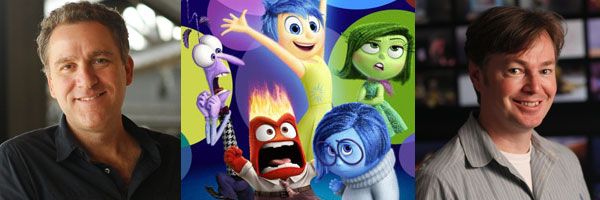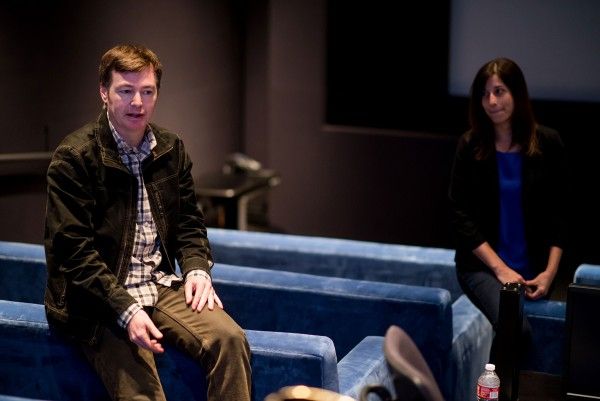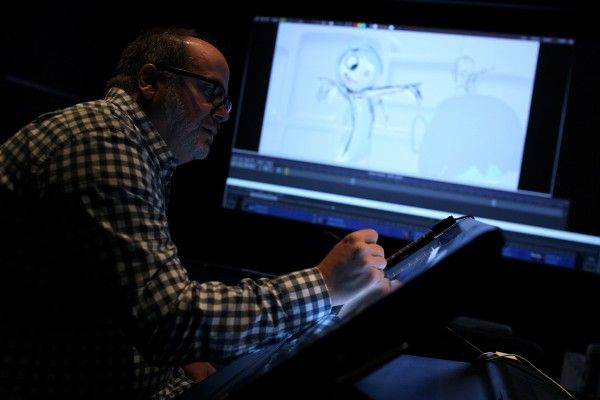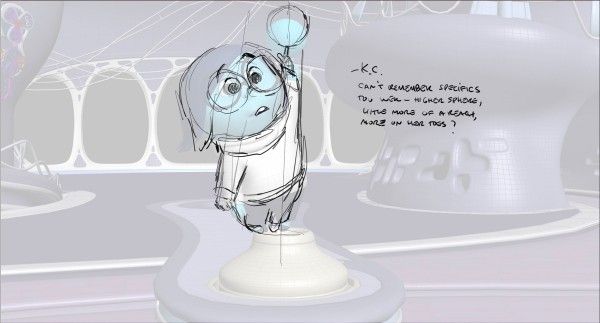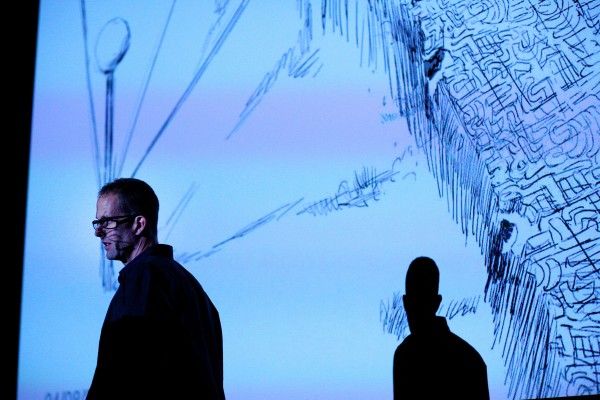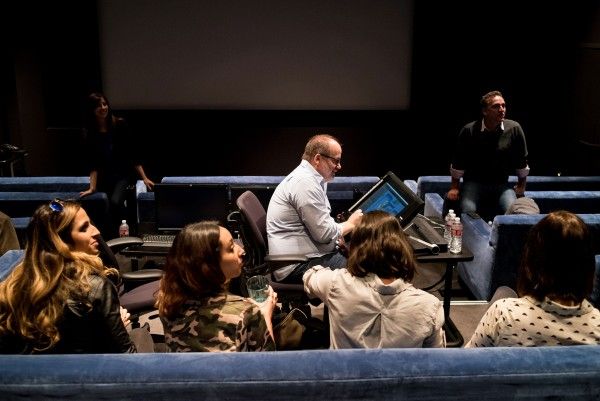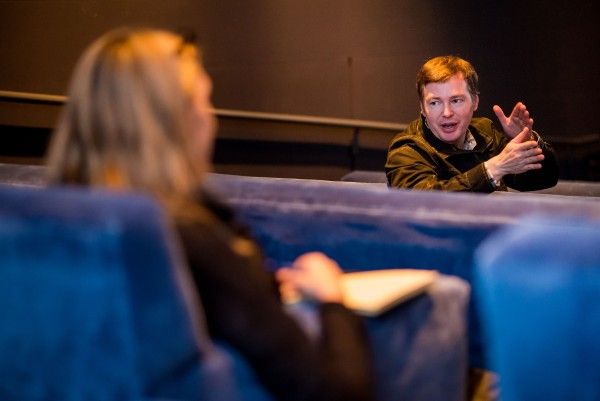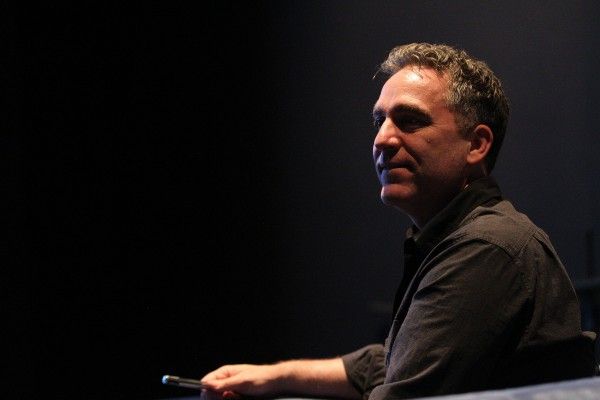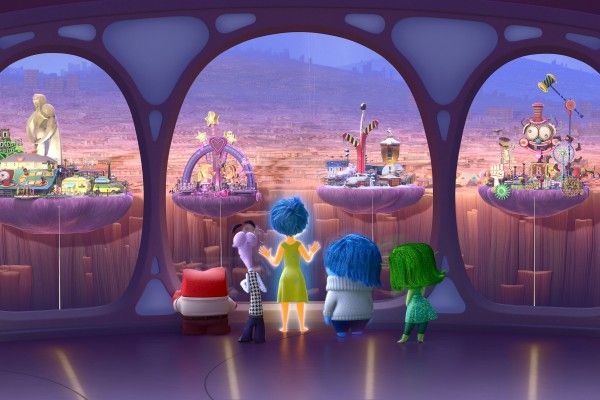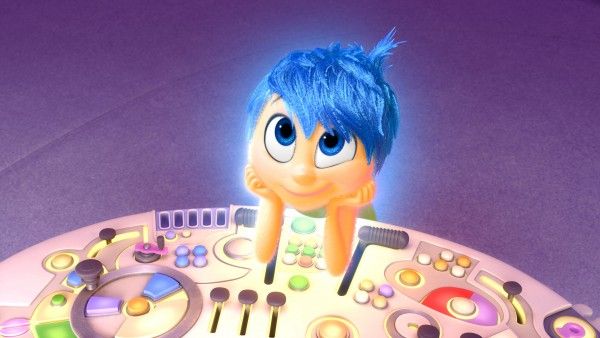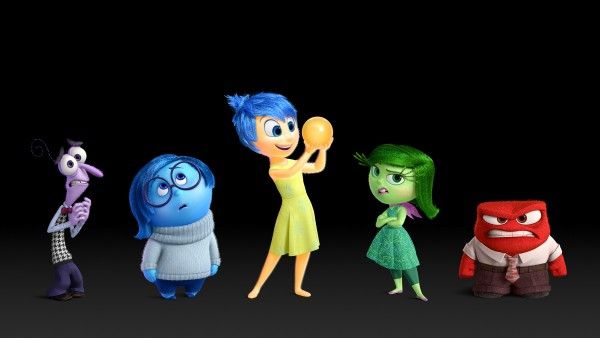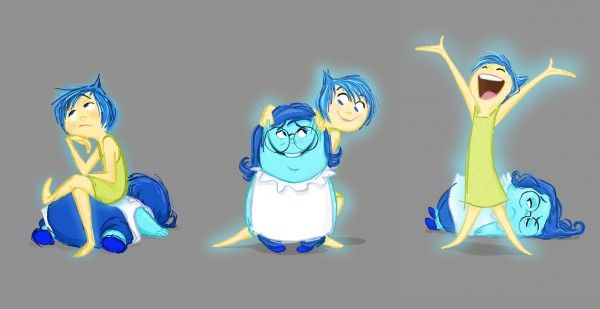If you caught my “39 Things to Know about Making a Movie at Pixar” feature, you’re already well aware that it takes a lot of talented artists to put one film together, and Shawn Krause and Victor Navone manage a good deal of them as supervising animators. After their group presentation during the Pixar tour, I got the opportunity to sit down with them two-on-one to discuss exactly how they split up the workload between the two of them, what it might be like to get a significant amount of feedback during a dailies session and more.
Check out what they had to say about their experience working on Inside Out in the interview below. Inside Out hits theaters on Friday, June 19th. Since sharing my thoughts on the first 56 minutes of the film I’ve had the chance to see the full thing and can confirm, it’s definitely one of Pixar's best.
Question: Can you guys tell me about sharing the Supervising Animator position? Do you separate the duties or is everything done together?
SHAWN KRAUSE: He does all the hard stuff. I do all the fun stuff. [Laughs]
VICTOR NAVONE: It’s something that’s kind of being discussed at the studio. Some films only have one supervisor; obviously we have two. It’s great because it does allow us to divide up responsibilities. We have different areas of interest. A lot of time we overlap. We’re both giving feedback to the animators, we’re both working with the director, but I might be taking over some of the more technical meetings and he might be taking over some more of the earlier artistic meetings. For example, he’s involved in location scouting and layout meetings, and I’m looking at effects and simulation or things like that. So we kind of just pick and choose how we want to divide up the tasks.
KRAUSE: Yeah, it really worked well in our case I think. There’s overlap for sure, but we do have different obsessive areas we want to work on. [Laughs]
I was thinking having two people could be a good way to manage the real world and the mind world material, but I guess it doesn’t work that way. [Laughs]
NAVONE: [Laughs] It didn’t end up that way. No, it was really lucky that Shawn and I got along and I feel like we really complement each other in our skillsets and our interests so that just happened to work out very well.
Can you tell me about Tony [Fucile]’s position? You mentioned that that’s a new one during the presentation. Did he just come on for Inside Out or is that a permanent position you guys would like to incorporate when making future films?
KRAUSE: It kind of came about because we were talking about movies we loved and one of them was Tangled, and there was a level of appeal they got to on that film. Glen Keane was the co-director on that, and he would draw over all these drawings. I think he said he even did more drawings on that film than he did on Tarzan, which is crazy. So as we were thinking, ‘how are were gonna get that level’ - not that we couldn’t already with our team - but how are we going to ensure this? We were thinking, well, there’s a level of 2D history that Glen had that we’d love to be able to reinforce at this studio. Tony was around and he was already helping out on the film …
NAVONE: Although Tony came back to the studio. He was on break doing children’s books, but when he found out about this film, he really wanted to work on it. And he also worked in story and art, and we were lucky enough to be able to grab him for animation as soon as he was done in story and art, and it just worked out beautifully. But it’s the first time we’ve had the full time role for that, like you said, and although it won’t always be him, I think it’s gonna be something we have on all our films from here out.
KRAUSE: And while we already incorporate as many of the principles of animation as we can, the way you think about animation in 2D - spacing of every frame - a lot of things are automated once we set key poses down. It sort of forces creative decisions beyond what’s given to us, and it’s challenging sometimes. So Tony brought that graphic style, brought that 2D sensibility and filled in the holes where maybe we can improve. And someone with his pedigree to come in, with his history and his respect, no one questioned it.
NAVONE: Because Tony worked on Iron Giant, he worked on Lion King, Little Mermaid. He’s a wonderful 2D animator.
KRAUSE: Family Dog.
Is that one of the first people you’ve seen that’s come in with a 2D mindset?
NAVONE: No, actually. We’ve hired plenty of animators with 2D backgrounds. In fact, we’ve even hired animators who never touched the computer before they got here.
KARUSE: Originally, most of us back 20 years ago, were trained 2D first and then you’d learn the computer.
NAVONE: It’s a lot easier to teach someone how to use a computer than it is to teach someone how to be an artist, so we figured if they can animate with a pencil, we can teach them how to animate with a computer.
That’s pretty fair. Can you tell me about the dailies process, and maybe what went through the most drastic transformation from start to finish?
KRAUSE: Going back to Tony, we thought editors would show their work - it’s not really dailies, but it’s an extension of that. We didn’t know how much Tony would do in dailies. We didn’t know what that would be, how that would work. Is it gonna be clumsy to have Pete [Docter] and Tony in there together? So Tony was just suggesting things, and it was a nice thing. Pete has a real comfort level with Tony, so it really worked well. I think that smoothing out the kinks to that, having those drawings and sending them back to animators’ offices, that process became standardized by the end. That was one of the things in dailies.
NAVONE: I’m just thinking about the Robb Denovan shot. It’s a beautiful scene where Joy is ice skating along with a memory of Riley, and that shot I think went through four different versions. This is one of the risks, not necessarily of dailies but of working on a film is that things change. Every time Rob would show in dailies, the co-director Ronny Del Carmen and Pete Docter would just discuss, ‘Is Joy like ice skating with herself or is she more watching Riley? Should she be doing tricks, or should she be following along?’
KRAUSE: Also, what is the story demanding?
NAVONE: Yeah, what’s the story demanding? What’s this moment really about? So poor Rob had to animate the shot like four times. And there were notes coming from outside of the department.
KRAUSE: And that happens in every shot.
NAVONE: There’s a contentious point. No scene is special, but what is the right solution for this scene? They would take away time, then they would add time. That was probably the worst case scenario of a daily situation where you’re showing work and people are tearing it apart and you’ve got to redo it and bring it back and they tear it apart again. Dailies can be a terrifying experience. Even for us. We’ve been here a long time, but showing a piece of animation for the first time to your peers is like basically standing in front of the room with your pants down. If this is supposed to be funny and they don’t laugh, then I’m just gonna have to crawl back to my office later and start over.
The clip you guys showed us had a really happy ending with the animation being approved, but all I kept thinking of was standing up and giving an oral presentation or the horror of getting a test grade back.
NAVONE: Yeah, we didn’t show you dailies where something went wrong or somebody got really re-directed. It happens more often than not, but it’s nobody’s fault.
KRAUSE: And even as new people come in too, we’ve always had a culture of speaking up in dailies, so we’re always talking. We’ve been here for years and we’re leads, but I think by the end of production, because Pete’s so collaborative and people felt very comfortable, there was a lot more talking. So that’s another thing that evolved in a very positive way, is that everyone was participating in a big way.
NAVONE: We always try to encourage discussion in the room because a lot of times newer animators who are just out of school or people come from other studios, they’re gonna have different points of view and we want to make sure we’re vetting all the ideas to get the best ones.
KRAUSE: Or they didn’t work in a place where that was welcome. It was like they were told what to do, they showed it to the leads maybe, never to the director.
NAVONE: A lot of people are shy about speaking up if this is their first time at Pixar or if they don’t have a lot of experience, so we try to encourage that.
How about the design of Bing Bong specifically? I imagine that could have gone a number of ways. Was he what we see in the final cut early on in this process?
KRAUSE: He kinda was.
NAVONE: Yeah, I think they nailed him pretty early on.
KRAUSE: Chris Sasaki designed him.
NAVONE: Yeah, Chris Sasaki. I don’t want to say it was easy for Chris, but once we saw that design, we knew this character’s great. We kind of know what to do with him and how he should move.
KRAUSE: And his voice landed too really easily. We did a few things, they looked around, but it was like, ‘Richard Kind, all right.’
NAVONE: Yeah, and the trick with him was really, okay, well, what’s the best way to articulate this trunk so it’s easy to animate? And we want to get these really simple sort of licorice shapes out of his lips, what’s the best way to do that? And always keep in mind that he’s a character who has the worldview of a three-year-old, and just keep simple shapes, simple expressions. You know you don’t want to do anything too sophisticated with him because he’s really a simple guy and you don’t ever want to betray that.
How about the design of the Forgetters? Did they evolve at all?
KRAUSE: They evolved a little bit. There was a point where they didn’t want to confuse them with any other characters that had been out there, or treat them like other characters had been treated out there, so we actually built them a certain way and then they evolved a little bit graphically after we had them in the computer. So there was a little bit of change with that.
NAVONE: We tried to give them more of a blue-collar feel I think for that sequence.
KRAUSE: Yeah, it depends on the sequence. Well, that was the Forgetters, and then there was all the stuff later on with the Dream Productions. It was fun for us because Paul Mendoza led the sort of second unit and they were taking these background characters that didn’t have a lot of personality and they injected so much personality into each of these things, and then we’d see it all at once on the screen, and we’re like, ‘Wow, look at that guy! Look at that guy!’
NAVONE: When you look at Dream Productions when they first walk in, every little character is doing something different. There’s a lot of little Easter eggs in there.
I was asking Jonas [Rivera] about Easter eggs before so now I have to go back and look at that scene too.
NAVONE: And everybody should see the movie multiple times! Pay for your tickets!
Based on what I’ve seen so far, I bet a lot of people will.
NAVONE: I certainly hope so.
Another thing I’ve had a lot of fun thinking about since I saw the movie was the personality islands, and what mine would be. Have you guys given any thought to that?
NAVONE: Another good question that I’ve never heard before!
KRAUSE: I know that we’ve talked about that for things like, if anything comes up down the road with maybe a theme park potential. With marketing, you look at everything. We’ve discussed those kinds of things.
NAVONE: Are you saying what would our personality islands be?
Yeah.
NAVONE: Oh, I’d definitely have like a Star Wars island, a Jaws island.
KRAUSE: I have a pizza island.
NAVONE: You have an electric guitar island.
KRUASE: Yes, that’s true. I have an obsessive electric guitar island.
NAVONE: I’ve got a couple of islands that don’t bear mentioning in a magazine. [Laughs] Probably a sushi island.
KRAUSE: Nerdy animation island.
NAVONE: Yes, definitely lots of nerd islands.
KRAUSE: Insecurity island. [Laughs]
Now how about the HQ control board? You told us a little bit about things that influenced what it would look like and what it could do, but can you go into a little more depth on that?
KRAUSE: Well, we told you about all the different ones we tried. Once we kind of landed on, okay, it’s Star Trek Enterprise - because I told you about the splash and stuff like that, right?
NAVONE: We tried a lot of really abstract ways they could interact with Riley, from throwing colored light around to dancing, you know, what it’s gonna be? And then it’s just like, control panel, it’s just the simplest thing. You just get it. You look at it, a few buttons, I get it, okay.
KRAUSE: And once we went into production, we looked at it with sets and we said, ‘What do these buttons do for consistency?’ And then the middle button was always like, if Anger got mad, he’d pound on that and those things would pop up and you’d go forward with it. And we just wanted to make sure that when they were hitting these buttons they were, with reason, the same thing. We had a rule first that when they touch it, that means they’re controlling it and it changes colors, so we worked with that a little bit.
NAVONE: Although after a while, I think we kind of threw out the continuity of what button does what. It’s just more like, ‘Well, what’s gonna look coolest in the situation?’ So you could say that the levers are like her adrenaline levers, but we bend our own rules a little bit based on what the scene needs.
KRAUSE: Yeah, this movie was sculpted from beginning to end and Pete and Jonas were great and persistent about ensuring that it led somewhere. But everyone, speaking for the animation department in particular, everybody contributed on every level to every character in every scene. They brought it and they were tireless. It was remarkable to watch.
NAVONE: It was a labor of love. Everybody was really invested in it.
It seems that way. You can feel it. Is there any specific idea that either of you came up with during this process that made it into the final cut that you can look at and say, ‘That’s mine?’
NAVONE: We make so many little suggestions because we’re looking at everybody’s shots. Like, ‘What if you try it that way’, or, ‘What if you move that pupil over there or adjust that pose a little bit.’ It’s hard to really pick out one.
KRAUSE: Yeah, because everyone really does add a thing here, a thing there.
NAVONE: That’s part of the fun of being a supervisor. You kind of get to shape the film as a whole rather than crafting a complete scene. It’s like, ‘Well, that picture’s not mine, but that brushstroke over there, I kind of directed that, and that brushstroke.’ I can’t really think of one in particular that I feel like I own, except for a couple shots that I animated, which is fun. But feeling like you contributed to the whole is the most satisfying thing.
So you guys give yourselves shots to animate as well?
NAVONE: We do.
KRAUSE: Early on, it’s easier and then later on it becomes a matter of, do we need a shot this week? Okay, I’ll try to do a short one quickly to help out.
NAVONE: Here’s a shot of a memory sphere rolling. We take a lot of the quick, crappy shots that nobody else wants just because we don’t have time.
KRAUSE: Crappy shots? There are no crappy shots! [Laughs]
NAVONE: Well, that’s true, okay. The throwaway shots or the simple shots just so that the crew doesn’t have to do them and because it’s all we have time for sometimes because we’re so busy with meetings.
That’s probably great for you guys to have a hand in that, too!
NAVONE: Absolutely.
KRAUSE: Now that it’s done, we want to go back into the fold and animate for a while again because the technology changes on every film. And you get in touch with your peers. It’s like, we’re only in this role for a period of time and we just have different responsibilities when we step into this role.
NAVONE: We’ve got to stay on our game, make sure we still remember how to animate.
You can catch up with all our Inside Out interviews below.
- Kyle MacLachlan on INSIDE OUT, the Diversity of His Characters, TWIN PEAKS, and More
- INSIDE OUT Director Pete Docter Talks Easter Eggs, TOY STORY 4, and More
- Bill Hader on INSIDE OUT, Working with Spielberg on THE BFG, and MAD MAX: FURY ROAD
- Watch INSIDE OUT’s Bill Hader Play “Save or Kill”

